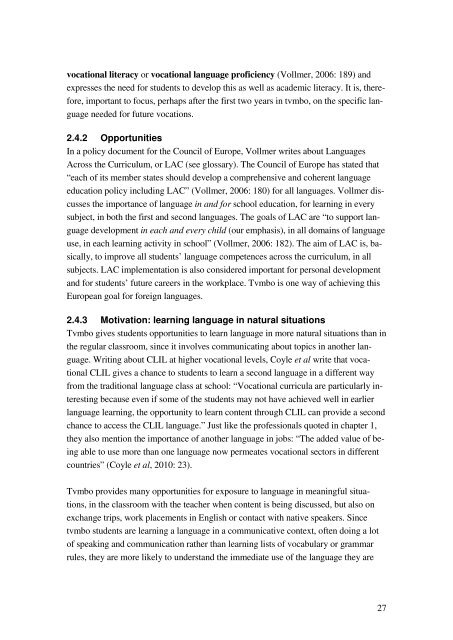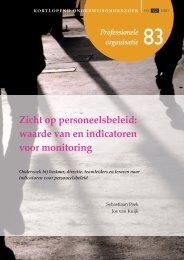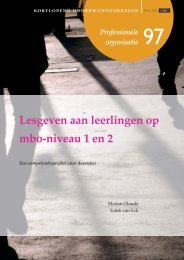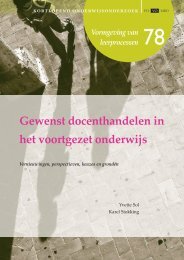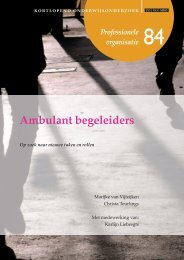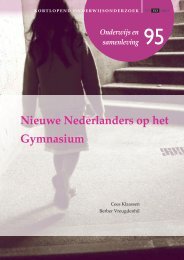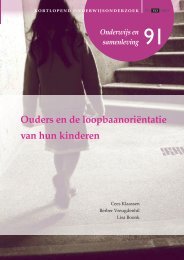Proud to be tvmbo - Kortlopend Onderwijsonderzoek
Proud to be tvmbo - Kortlopend Onderwijsonderzoek
Proud to be tvmbo - Kortlopend Onderwijsonderzoek
You also want an ePaper? Increase the reach of your titles
YUMPU automatically turns print PDFs into web optimized ePapers that Google loves.
vocational literacy or vocational language proficiency (Vollmer, 2006: 189) and<br />
expresses the need for students <strong>to</strong> develop this as well as academic literacy. It is, therefore,<br />
important <strong>to</strong> focus, perhaps after the first two years in <strong>tvmbo</strong>, on the specific language<br />
needed for future vocations.<br />
2.4.2 Opportunities<br />
In a policy document for the Council of Europe, Vollmer writes about Languages<br />
Across the Curriculum, or LAC (see glossary). The Council of Europe has stated that<br />
“each of its mem<strong>be</strong>r states should develop a comprehensive and coherent language<br />
education policy including LAC” (Vollmer, 2006: 180) for all languages. Vollmer discusses<br />
the importance of language in and for school education, for learning in every<br />
subject, in both the first and second languages. The goals of LAC are “<strong>to</strong> support language<br />
development in each and every child (our emphasis), in all domains of language<br />
use, in each learning activity in school” (Vollmer, 2006: 182). The aim of LAC is, basically,<br />
<strong>to</strong> improve all students’ language competences across the curriculum, in all<br />
subjects. LAC implementation is also considered important for personal development<br />
and for students’ future careers in the workplace. Tvmbo is one way of achieving this<br />
European goal for foreign languages.<br />
2.4.3 Motivation: learning language in natural situations<br />
Tvmbo gives students opportunities <strong>to</strong> learn language in more natural situations than in<br />
the regular classroom, since it involves communicating about <strong>to</strong>pics in another language.<br />
Writing about CLIL at higher vocational levels, Coyle et al write that vocational<br />
CLIL gives a chance <strong>to</strong> students <strong>to</strong> learn a second language in a different way<br />
from the traditional language class at school: “Vocational curricula are particularly interesting<br />
<strong>be</strong>cause even if some of the students may not have achieved well in earlier<br />
language learning, the opportunity <strong>to</strong> learn content through CLIL can provide a second<br />
chance <strong>to</strong> access the CLIL language.” Just like the professionals quoted in chapter 1,<br />
they also mention the importance of another language in jobs: “The added value of <strong>be</strong>ing<br />
able <strong>to</strong> use more than one language now permeates vocational sec<strong>to</strong>rs in different<br />
countries” (Coyle et al, 2010: 23).<br />
Tvmbo provides many opportunities for exposure <strong>to</strong> language in meaningful situations,<br />
in the classroom with the teacher when content is <strong>be</strong>ing discussed, but also on<br />
exchange trips, work placements in English or contact with native speakers. Since<br />
<strong>tvmbo</strong> students are learning a language in a communicative context, often doing a lot<br />
of speaking and communication rather than learning lists of vocabulary or grammar<br />
rules, they are more likely <strong>to</strong> understand the immediate use of the language they are<br />
27


